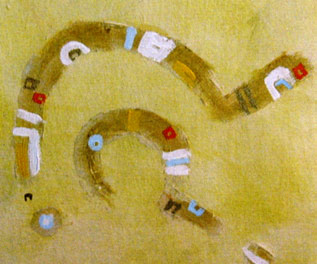


Ceiling Painting in the Intensive Care Unit – a doctor´s considerations
Everything that takes place in a hospital must serve the patients´ healing. Art in a hospital must support the recovery process and make the patient´s suffering more tolerable: art has in a hospital a demanding function to fulfill.
Art can create a warm atmosphere for the patients and employees, it can communicate a feeling of security and radiate hope.
Another possible use for art in a hospital is to stimulate the powers of perception.. But which patients would profit from such art? We thought of those patients in the intensive care units, who have suffered serious injuries, have undergone major operations or are in life- threatening situations. These patients have disturbed powers of perception – either by the trauma or anesthesia itself, by medications, or by a passive mental state brought about by the medical equipment itself.
What really do we wish to achieve for the patients with these means?. We wish to make the patient active by means of intellectual stimulation!
To do this his or her powers of perception must be „once again“ stimulated, so that the patient´s own senses can, with their own powers, support the process of recovery.
These were our considerations when we approached the artist, Katrin Hattenhauer, on the subject of how „art in the hospital“ could be put into effect in intensive care units.
Indeed, there have already been considerations on this subject. Dr. Meier-Hellmann, at the time chief physician in charge of the intensive care unit (ICU) at the University Clinic in
In January 2003 Nurse Bluhm managed to bring all potential participants in this project together: the artist, architect, supporters of the hospital, that ist, those who would finance the project.
Now we ar pleased and proud that our supporters have realized this idea for „stimulation of intensive care patients.“
In this context I would like to cite something from the magazine „Mensch und Büro“ („People and the Office“). In the article, „Pictures Say More Than a Thousand Words“, the author notes that the dialogue with art initiates new thoughts, enters into dialogue with the viewr an encourages communication.
The author further notes on the subjekt of the psychological effects of art that: works of art influence peoples´ moods toward work morale and productivity in their places of buisness – in both the positive and negative sense. This is the conclusion of an international study undertaken by
The choice of a picture can also allow clear conclusions about the persons who owns it. „ A Picasso on the wall of an authoritarian CEO can throw salt into the wounds of his employees“, Sigmann explains.
But single characteristics are not all that on can deduce from the choice of image. A whole company can reveal its inner character by the choice of art it presents. Sigmann: „Employees should be sensitive to the fact that the secret life of a company and its goals is written on the walls.“
What do these perceptions mean for the art in our hospital?
Art in its creativity will support our employees, that ist, caretakers and doctors in the intensive care unit and will contribute to a calm atmosphere and improve their moods. This will, I think, most certainly apply to the patients and their family members, who are often in a difficult state of mind. In this context paintings which are not representational are most suitable: on the on hand, they have a calming effect, while on the other they arouse curiosity. They encourage perception and fantasy and thus the body´s own power to beal itself.
The connection between art and its effects on patients and caretakers described above has unfortunately not been documented by careful scientific research. Nonetheless, we can describe the positive results in our hospital: our patients, their families and employees describe, when they are questioned a time after they have been in the intensive care unit and in our hospital, a positive and warm atmosphere, a stimulating situation. Why is this so? Patients, their families, visitors and hospital employees not only are received by art in the reception area, and accompanied by it throughout the building but also encounter art even at that place where everything is truly „at it worst“, namely the intensive care unit. Art is, so to speak, something of a red line through the whole and does not avoid supposed challenges. No, art develops rather its hoped-for effects when it stimulates in the most critical location in the building, activates and at the same time bequeaths an atmosphere of security and hope
The artist, Katrin Hattenhauer, painted the ceilings of two rooms in the intensive care unit in two highly different ways: fillled with fantasy and at the same time polarizing - ultimately though, exactly the way we wanted it to be done: „stimulation of patients“ and employees´ perceptions!“
One patient once spontaneously remarked, perhaps representative for many others, when she was asked about the ceiling paintings, „... I fell good, am not bored, more than that it encourages me to think when I look up...“
What more could we wish for, really?
